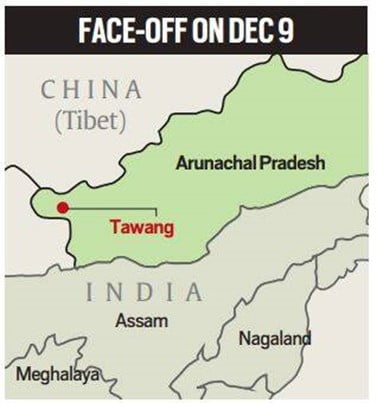ARCHIVES
Syllabus
- GS-2: India and its neighborhood- relations.
Context: “PLA troops tried to transgress the LAC in Yangtse area of Tawang Sector and unilaterally change the status quo”
- The clash in the early hours of December 9 took place after Chinese troops on regular patrol on their side of the Line of Actual Control (LAC) in the “Dongzhang” area were blocked by Indian soldiers who had “illegally crossed the line”.
- The clash in Tawang took place two and a half years after the deadly encounter between the two sides in the Galwan Valley in Ladakh in June 2020.
Where is Tawang the site of clash?

- Soldiers of the two sides clashed in an area called Yangtse, in the upper reaches of Tawang sector in Arunachal Pradesh.
- Tawang, indeed nearly all of Arunachal, is claimed by China.
- It is one of the more serious dispute points between India and China in the overall border question.
- Tawang is the birthplace of the sixth Dalai Lama and an important pilgrimage centre for Tibetan Buddhists.
- The current 14th Dalai Lama took refuge in Tawang after he crossed over from Tibet to India in 1959, spending some days in the monastery there before proceeding further.
- Within Tawang, there are three “agreed areas” of differing Indian and Chinese perceptions of the LAC. Yangtse, which is about 25 km from Tawang town, north of the Lungroo grazing ground, is one of these areas.
- As a result, it has been the site of regular “physical contact” between the Indian Army and the PLA, especially as the high ground is on the Indian side, giving it a commanding view of the Chinese side.
- The December 9 incident is the most serious encounter between the two sides in recent years in this sector, and the first one resulting in injuries since the Galwan clash, in which 20 soldiers on the Indian side and an unspecified number of Chinese troops lost their lives.
What is the context of new India-China crisis at Tawang?
- Indian Defence Minister stated that the Indian troops had confronted the PLA, and a “physical scuffle” ensued, which had prevented the Chinese from transgressing into Indian territory and compelled them to return to their posts. It caused injuries on both sides, but no fatalities.
- The PLA’s motivation for creating a new crisis along the disputed border, this time in the east, “appears to be to extend the points of confrontation and keep the issue of India China border alive at a time when the world is engaged in overcoming multiple crisis emanating from the Ukraine war.
- After the PLA incursions into eastern Ladakh in April-May 2020, the two sides held 16 rounds of talks for disengagement at the so-called “friction points”
- Friction points here mean areas where the incursions had taken place, and Indian patrolling parties were being prevented from accessing places that they had patrolled earlier
- The disengagement has led to the withdrawal of both sides from eyeballing each other at such places, including Galwan, Pangong Lake, Gogra and Hot Springs, and the creation of “buffer areas” at these places. While this has reduced the chances of trigger situations, the status quo that existed before the incursions has not been restored.
- The de-escalation of tensions envisaged under this plan has proved elusive, infrastructure development on the Chinese side has continued apace, including the building of roads and even two bridges over Pangong Tso, giving the PLA easier access to the souther bank of the lake.
- The Indian side also has tried to keep pace with frenetic roadworks and other construction on its side.
- As yet, there is no indication that the Chinese want to talk about resolving the Depsang and Demchok “friction points”.
- Over the last two years, the deployment of troops in the forward areas of the LAC at Ladakh has become a permanent feature.
- The Yangtse incident came days after China said that the joint India-US military exercise Operation Yudhabhyas had violated the terms of the 1993 and 1996 border agreements.
- The Chinese activation in the eastern sector is to be viewed against this backdrop of military tensions, and serves to divide the attention of India’s security planners as it deals with new situations.
What lies ahead?
- New Delhi believes that the Chinese actions in Tawang were tantamount to the tearing of painstakingly negotiated border agreements
- China however has said both sides were maintaining open communication on border-related issues through diplomatic and military channels.
- The incident is certain to add a fresh layer of mistrust in India’s perception of China’s intentions. India has clearly stated that the bilateral relations cannot be normalised without peace and tranquility on the border.
Main Practice Question: What are the reasons for China’s recent attack in Tawang? What are the strategic implications of such frequent border clashes?
Note: Write answer his question in the comment section.














